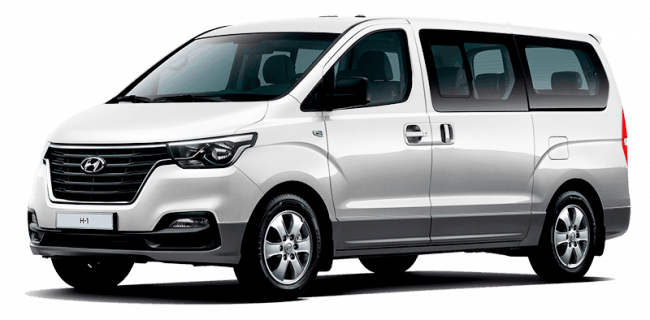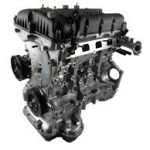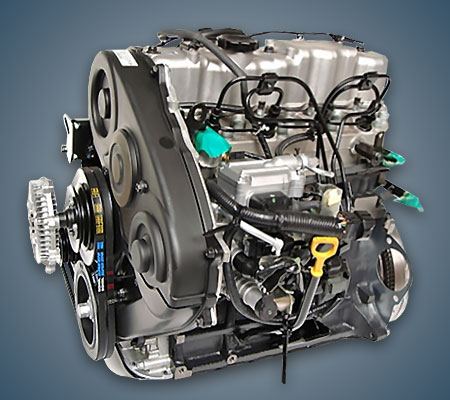
Engines Hyundai Starex, Grand Starex
Content
The history of the creation of multi-purpose full-size minibuses at Hyundai Motor Company began in 1987. During this period, the company is engaged in the production of the Hyundai H-100, the first volumetric minivan in its lineup. The construction of the car was carried out on the basis of the Mitsubishi Delica, which was popular at that time. The vehicle received a more voluminous and roomy body, but in general the technical part remained unchanged. It is not surprising that the model was successful both in the domestic (the car was produced under the name Grace) and in the international markets.

On the wave of popularity, the company's engineers, relying entirely on their own resources, design and put on the conveyor in 1996 the Hyundai Starex car (H-1 for the European market). The model turned out to be very successful and, in addition to Korea, was produced in Indonesia. And since 2002, Hyundai Corporation has issued a license for the production of this car to the People's Republic of China. In China, the model was called Reline.
Hyundai Stareks I generation was produced with two types of chassis:
- A short.
- Long.
The car had several options for completing the interior. Starex passenger minibuses could be equipped with 7, 9 or 12 seats (including the driver's seat). A distinctive feature of the car is the ability to rotate the passenger seats of the second row in any direction in 90-degree increments. Cargo versions of the vehicle had 3 or 6 seats. At the same time, the glazing of the car interior could be complete, partial or completely absent.
Over the entire period of production of the first generation Hyundai Starex from 1996 to 2007, the car underwent two upgrades (2000 and 2004), in the code of which not only the appearance of the vehicle, but also its technical part underwent a major change.
II generation or more, higher and more luxurious
The second generation of Hyundai Starex, which has fallen in love with many car owners, was presented to the general public in 2007. The new car had nothing in common with the previous model. The body has become wider and longer, acquired modern features. The interior capacity of the vehicle has also increased. The Starex 2 model range was offered with 11 and 12 seater saloons (including the driver's seat). In the domestic (Korean) market, such cars received the Grand prefix.
II generation Grand Stareks enjoys wide popularity in the Asian region. So in Malaysia, a version is produced for countries with left-hand traffic. Such cars have even richer equipment (Hyundai Grand Starex Royale).
Grand Starex cars are sold with a 5 year warranty (or 300 km). Also, like the first generation, the vehicle is offered in several versions:
- Passenger option.
- Cargo or cargo-passenger (with 6 seats).
In 2013 and 2017, the car underwent a slight restyling, which mainly affected only the exterior details of the car.
- What engines were installed on different generations of cars
In the period from 1996 to 2019, the following models of power units were installed on both generations of the car.
First generation Hyundai Starex:
| Petrol power units | ||||
| Factory number | modification | engine's type | Developed power hp/kW | Working volume, see cube. |
| L4CS | 2,4 atmospheric | 4 cylinders, V8 | 118/87 | 2351 |
| L6AT | 3,0 atmospheric | 6 cylinders, V-shaped | 135/99 | 2972 |
| Diesel power units | ||||
| Factory number | modification | engine's type | Developed power hp/kW | Working volume, see cube. |
| 4D56 | 2,5 atmospheric | 4 cylinders, V8 | 105/77 | 2476 |
| D4BB | 2,6 atmospheric | 4 cylinders, V8 | 83/65 | 2607 |
| D4BF | 2,5 TD | 4 cylinders | 85/67 | 2476 |
| D4BH | 2,5 TD | 4 cylinders, V16 | 103/76 | 2476 |
| D4CB | 2,5 CRDI | 4 cylinders, V16 | 145/107 | 2497 |
All Hyundai Starex power units were aggregated with 2 types of gearboxes: a mechanical 5-speed and a 4-speed automatic with a classic torque converter. The first generation cars were also equipped with the PT 4WD all-wheel drive system. Part Time (PT) means that the front axle in the vehicle is connected forcibly from the passenger compartment.
Second generation Hyundai Grand Starex:
| Petrol power units | ||||
| Factory number | modification | engine's type | Developed power hp/kW | Working volume, see cube. |
| L4KB | 2,4 atmospheric | 4 cylinders, V16 | 159/117 | 2359 |
| G4KE | 2,4 atmospheric | 4 cylinders, V16 | 159/117 | 2359 |
| Diesel power units | ||||
| Factory number | modification | engine's type | Developed power hp/kW | Working volume, see cube. |
| D4CB | 2,5 CRDI | 4 cylinders, V16 | 145/107 | 2497 |
Three types of gearboxes were installed on the second generation Grand Starex:
- 5-6 speed automatic (for diesel versions).
- Automatic gearbox with 5 speed ranges (installed cars with diesel internal combustion engines). A 5-speed automatic is considered the most preferred option. Japanese reliable JATCO JR507E is able to work out up to 400 thousand kilometers.
- A 4-speed automatic transmission was installed on vehicles with gasoline engines.
On cars produced in 2007-2013, there was no all-wheel drive system. Only after restyling, the manufacturer again began to equip Grand Starex with 4WD systems. But these cars were not officially supplied to the Russian market.
3. Which engines are most widely used
During the production period of Hyundai Starex from 1996 to 2019, the following models of power units were most widely used.
XNUMXst generation
Among all the first-generation Hyundai Starex cars produced by the company, the largest number of copies were equipped with two engines: diesel 4D56 and gasoline L4CS. The last of them was produced by the company from 1986 to 2007 and is an exact copy of the Japanese 4G64 engine from Mitsubishi. The engine block is cast from ductile iron, and the cylinder head is made from aluminum alloy. The gas distribution mechanism has a belt drive. The internal combustion engine is equipped with hydraulic valve compensators.
L4CS is unpretentious to the quality of oil and gasoline. This is not surprising, given the year of its development. The internal combustion engine is equipped with an electronic fuel supply system. In the combined cycle, Starex equipped with this engine consumes up to 13,5 liters of fuel, subject to the recommended operating mode. The power unit has one serious drawback. The gas distribution mechanism is not very reliable. On these motors, the drive belt often breaks prematurely and the balancers are destroyed.
The 4D56 diesel engine on the 1st generation Starex was borrowed from the Mitsubishi concern. The engine has been produced by the company since the 80s of the last century. The power unit has a cast iron block and an aluminum cylinder head. The timing is carried out by a belt drive. The maximum developed motor power is 103 hp. This engine is not able to provide good dynamics to the vehicle and has no less modest appetite than its gasoline competitor, but it can please the owner of the vehicle with somewhat greater reliability. The operating time of 4D56 before the first overhaul is 300-400 thousand kilometers and even more.
XNUMXnd generation
The second generation of Grand Starex cars in the vast majority of cases are equipped with a 145-horsepower D4CB diesel engine. The engine belongs to the family A according to the classification of the automaker and is relatively modern. Its release began in 2001 and since then the internal combustion engine has been regularly upgraded. To date, the D4CB is one of the most environmentally friendly powertrains from Hyundai Motors.
The engine block is made of ductile iron, the cylinder head is an aluminum alloy structure. The timing drive is carried out by means of a triple chain. The motor has an accumulator-type fuel system with high-pressure injectors (Common Rail). The engine is also equipped with a variable geometry turbine.


Watch this video on YouTube
The use of turbocharging has improved the dynamics of the vehicle, increased the power of the car and significantly reduced consumption. The D4CB installed on the Hyundai Grand Starex consumes up to 8,5 diesel fuel per 100 kilometers in the combined cycle.
4. Which engine is better to choose a car
It is very difficult to answer the question with which power unit to buy Starex. We can confidently say only about the priority of diesel engines over gasoline ones. But two power plants are more popular in the market for new cars and used cars:
- D4CB (installed on Starex 1 and 2 generations).
- 4D56 (found exclusively on cars of the 1st generation since 2000).
Both motors are relatively reliable and have a long service life, however, both power units have some drawbacks.
D4CB
For those wishing to purchase a second-generation Hyundai Grand Starex, this ICE is the only acceptable option for choice. Although the motor has a number of obvious design "diseases":
- Often there are cases of clogging of the oil receiver in the engine. This leads to oil starvation and mechanical damage to the liners. If you do not turn off the car in a timely manner after the onset of the first symptoms, it is possible to damage the turbine.
- The gas distribution mechanism with three chains is very short-lived and difficult to repair.
- A high pressure fuel pump from Delphi, which is installed on the Starex EURO 5. This injection pump often drives chips.

 D4CB
D4CB
4D56
This is a proven motor. When choosing Starex of the first generation, priority should be given to cars with this power unit. Although he still saved a few unpleasant surprises for motorists:
- Oil leaks from gaskets and seals are the most common ailment of internal combustion engines.
- After 100-120 thousand run, cracks in the area of the prechambers are not uncommon.

 4D56
4D56

